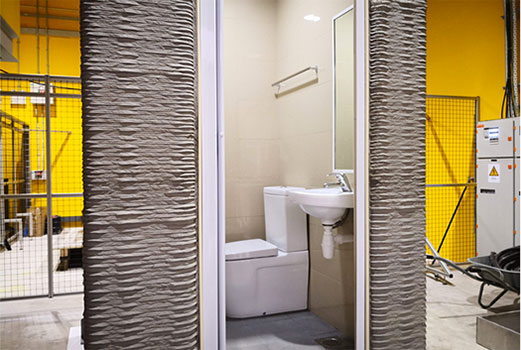Error, group does not exist! Check your syntax! (ID: 2)
Latest News
3D BATHROOM DESIGN

It’s amazing what you can do with 3D printing. From food and furniture to prosthetics and artificial organs, the technology is very versatile and will undoubtedly change the way industries work in future.
Now, researchers from Singapore’s Nanyang Technological University (NTU) have taken it one step further by successfully printing an entire unfurnished bathroom – all in 12 hours.
In a joint statement released by the university and the National Research Foundation (NRF) on Wednesday (May 22), the institutions said that the bathroom was printed using a special concrete mix, and later furbished with toilet fittings to become a pre-fabricated unit.
The bathroom, which NTU said is ready for use in construction projects, could be fitted with just about everything a typical toilet would have, including a sink, mirror, shower and toilet bowl.
It even had ceramic tiled walls and flooring as well as concealed drainage and piping.
The innovation, according to NTU, was developed by a joint research team comprising personnel from the university’s Singapore Centre for 3D Printing, in partnership with Sembcorp Design and Construction and Sembcorp Architects and Engineers.
The bulk of the research was said to be dedicated to developing and fine-tuning the concrete mix to make it fluid enough to flow through the hoses and print nozzle, yet able to harden rapidly enough to allow the next layer to be printed on top.
In addition to maintaining a consistent print quality, the final product had to be as strong as conventional concrete.
This alone was a four-year-long journey, said NTU.
More efficient than conventional methods
However, their breakthrough has opened the door to potentially helping firms build pre-fabricated bathroom units about 30 per cent more quickly and 30 per cent lighter than current pre-fabricated bathroom units that are constructed by concrete casting.
NTU added that the proof-of-concept aims to improve productivity for the nation’s building and construction industry by utilising digital and robotic manufacturing methods to reduce the need for skilled labour and excessive manpower.
The university said that since 2014, the use of pre-fabricated bathroom units in construction processes has been a requirement for all non-landed Government Land Sale (GLS) sites in Singapore.
Typically, pre-fabricated bathroom units are first cast from concrete and assembled offsite with all necessary finishes and fittings. The units are subsequently lifted and installed in a building project.
However, by relocating the assembly process to the controlled environment of a factory, time and manpower savings of roughly 60 per cent can be achieved, said NTU.
Better control over the materials and pre-fabrication process would allow for higher quality finishes and less wastage, the university added.
Associate professor Tan Ming Jen from the Singapore Centre for 3D Printing, who led the research team, said: “By being able to print-on-demand, companies can save on their inventory costs as well as manpower costs, as they don’t have to hold as much stock and their workers can be redeployed to do higher-level tasks.”
“This approach improves the safety of the workplace, since robots are doing the construction of the bathroom unit,” Tan added.
According to the statement, the larger 3D-printed pre-fabricated bathroom unit had already passed stringent industry tests for strength as well as robustness. It is currently undergoing fire resistance tests in compliance to the requirements under the Building Innovation Panel pre-fabricated bathroom unit acceptance framework.
The research team also aims to obtain the required approvals for trials from the Building and Construction Authority of Singapore (BCA) before commercialising the technology through licensing or a spin-off company, NTU said.
SOURCE: www.businessinsider.sg




Leave a Reply
Want to join the discussion?Feel free to contribute!